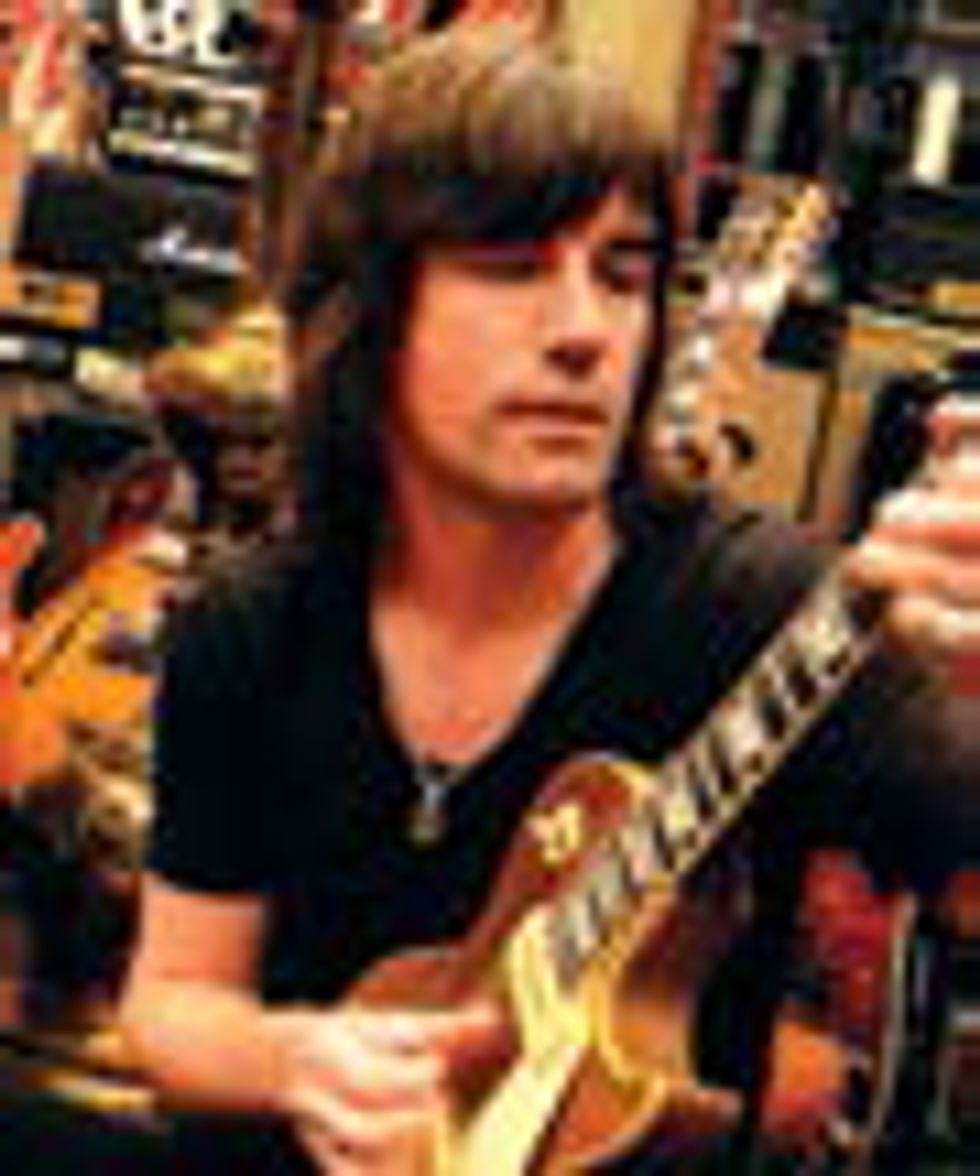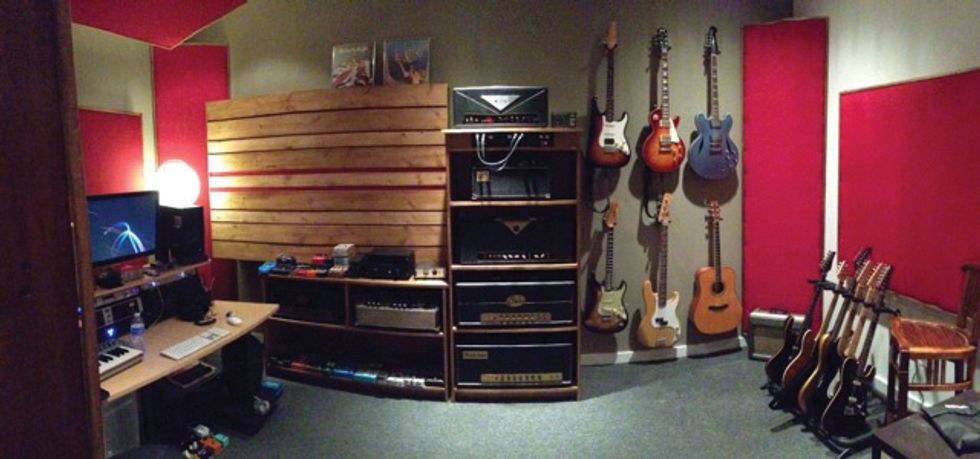Welcome to another episode in our never-ending quest for tone. Last month’s column, The Road Guitarist’s Studio, was all about mic’ing guitar cabinets. This month, I’ll focus on my new control room. I put quite a bit of thought into designing a space conducive to creative guitar tracking and mixing, and I aim to share what I’ve learned with you here.
Tuning the Room
The best gear in the world won’t help you
make great recordings if your listening environment
sounds bad. This means eliminating—or at least reducing—standing waves,
flutter echoes, and excessive bass waves. In
a perfect world, your control room would
have no parallel walls, because rooms with
numerous angles help break up standing
waves and other undesirable sonic artifacts.
My control-room area, however, is actually a less-than-perfect acoustical space because it’s essentially a rectangle. So, I enlisted the help of studio designer Keita Ishibashi to help me get things under control. Keita built custom bass traps for the corners of my room, as well as absorption panels and diffusers for the walls. The diffusers on either side of my mix position are really something special: They absorb bass from 70 to 350 Hz, and diffuse mid and high frequencies with the aim of not deadening the room more than necessary. And the bass traps in the corners are almost like a sonic vacuum—when sound goes in, it doesn’t come out. With the room tuned, the end result is true and clear sound when sitting in the mix position and listening to my Adam A7 monitors. I can dial in guitar tones and mix confidently knowing that my mixes will translate well.
Amps and Modelers
I mainly use heads and speaker cabinets, as
opposed to combo amps. I like the flexibility
of having the amp right beside me in the control
room so I can tweak the controls while I’m
listening through the studio monitors. And it’s
certainly nice to have the option of changing
speaker cabs. Keita made me some custom
cabinets that house my amplifier heads, and
there’s a patch bay at the top where the six
individual speaker outputs from the amps are
located. There are also two jacks for the two
speaker cable tie-lines that run into the room
where my speaker cabs reside. This allows me to easily patch an amp into a speaker cab. And
because there are two tie-lines, I can also use
two amps and two cabinets at once.
You could easily design something similar with shelving from your local big-box hardware store, foregoing the patch bay, and just having individual speaker cables coming from each of your amps. Just make sure you label each cable so you know what amp it’s connected to. It’s okay to use long speaker cable runs, but you should use high-quality speaker cables of a fairly heavy gauge (mine are 12 gauge).
I keep a wide variety of amp heads in my studio in an effort to have tonal options that range from clean to crunch to modern high-gain. Another staple in my studio is a Fractal Axe-Fx II. It always delivers stellar modeled-amp tones, as well as awesome effects. I even used it on a recent session to get a very lo-fi “small amp on the verge of exploding” sound, which is probably the last thing you’d expect it to be used for.
Guitars
I consider myself a traditionalist when it
comes to guitars, which is to say I’m a fan of
the tried-and-true classic designs. My main
guitars—both onstage and in the studio—consist of a mix of Gibson, Fender, Taylor,
and Martin guitars. I’m also a big fan of Suhr
guitars and I really like the EVH line for a
modern hot-rod-style axe. So I can cover all
the bases tonally in my studio, I generally
keep a total of 12 of these guitars, including
a good 12-string electric and a Gretsch hollowbody
to round out my arsenal. That said,
I think as long as you have a Strat, a Tele, a
Les Paul, and 6- and 12-string acoustics, then
you are well equipped for most sessions.
Mic Preamps and Interfaces
Your front-end signal chain is important
because digital recording is very unforgiving—what goes in is what comes out. So
it’s essential to use quality mic preamps
to ensure your guitar sounds are recorded
properly. I use an A2D from API and a
UA 6176 channel strip, both going into an
Apogee Ensemble audio interface. The API
preamps are “in-your-face” and aggressive,
which are great qualities if you are recording
electric guitar. And the UA tube pre is
warm, fat, and rather dark—a nice contrast
to the API unit.
DAW and Plug-in Software
Even though I’ve been a Logic user for over
10 years, I think all the popular DAW software
has evolved to the point where it’s hard
to make a bad choice. Logic works great
for me with its large collection of included
plug-in instruments and effects. But I also
use a number of third-party effect plug-ins
from companies such as Waves, Soundtoys,
and Slate Digital. I’m a fan of Steven Slate’s
SSD4 drum software for creating drum
tracks because it sounds incredibly realistic,
especially when using MIDI groove files that
were played by real drummers. No matter
what drum software you use, I recommend
amassing a big collection of groove files.
Companies such as Slam Tracks produce collections
of MIDI grooves, which make writing
and production so much easier.
Computers and Monitors
I use a Mac Pro 8-core tower as my main
studio computer, along with a 23" Apple
monitor. The Mac has 6 GB of RAM, a
640 GB system drive, and three internal 1
TB drives for audio, samples, and backup. I
believe it’s always best to use separate drives
for your system, audio tracks, and samples.
My goal in creating this studio was to make a creative, productive space for tracking world-class guitar tones with a minimum of fuss. I think I’ve achieved my goal and I hope that some of my ideas and suggestions will be helpful when you set up your own project studios. Until next month, happy tracking!
 Peter Thorn is an L.A.-based guitarist, currently touring
with Melissa Etheridge. His solo album,
Guitar Nerd, is available through iTunes and
cdbaby.com. Read more about his career at
peterthorn.com.
Peter Thorn is an L.A.-based guitarist, currently touring
with Melissa Etheridge. His solo album,
Guitar Nerd, is available through iTunes and
cdbaby.com. Read more about his career at
peterthorn.com.






![Rig Rundown: Russian Circles’ Mike Sullivan [2025]](https://www.premierguitar.com/media-library/youtube.jpg?id=62303631&width=1245&height=700&quality=70&coordinates=0%2C0%2C0%2C0)

















